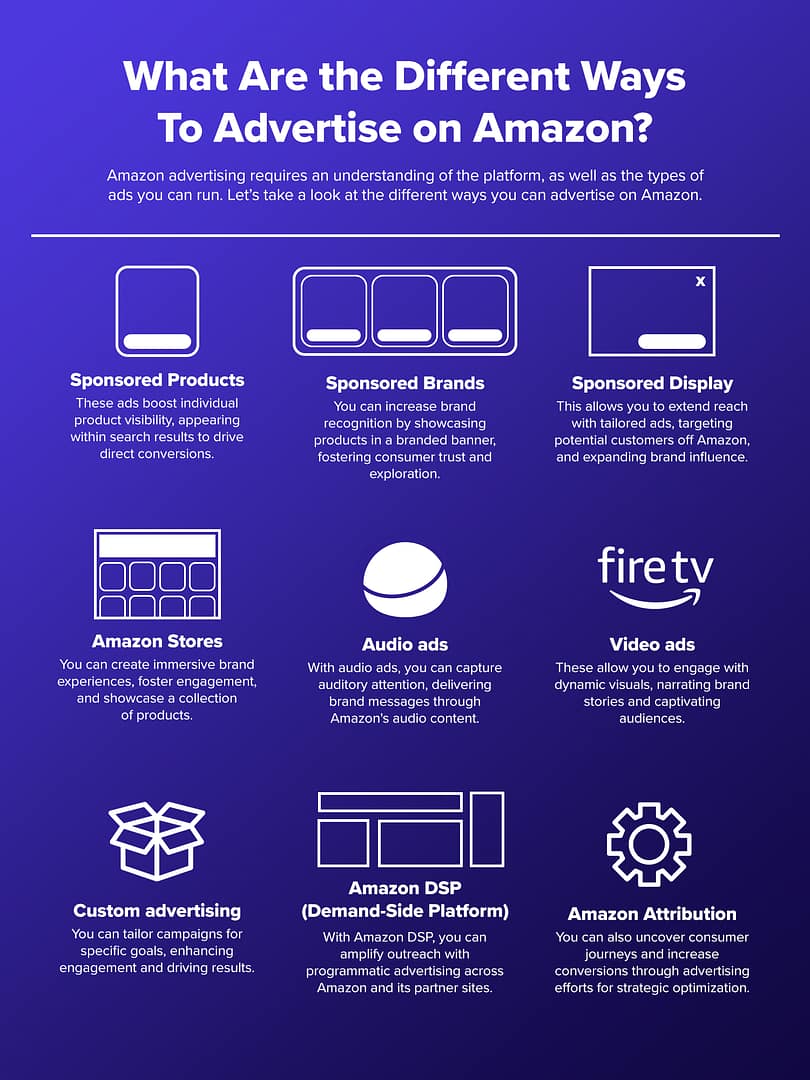In the competitive world of e-commerce, where digital environments change and consumer tastes fluctuate often, Amazon advertising holds plenty of potential. With the help of this innovative platform, companies of all sizes and stages can harness the potential of strategic visibility.
According to data gathered in AMZScout’s Product Database, Amazon has over 600 million products listed on its marketplace. This is because the e-commerce giant continuously seeks to improve and optimize product listing by incorporating product reviews, ratings, and other relevant information.
In this blog, we’ll unravel Amazon advertising costs and take you on a thorough tour of the complex elements of Amazon Ads’ pricing dynamics.
What Is Amazon and Who Uses It?
Amazon, the world’s largest hub of commerce, is at the center of the digital economy. It has an unmatched user base and has become synonymous with online purchasing.
Amazon Business, the B2B e-commerce channel, has over 1 million customer accounts worldwide, over 150,000 Amazon sellers, and more than $10 billion in annualized global sales. Its storefronts have also expanded to showcase over 2.5 million products from around 30,000 brands in various product categories in the United States.
The platform also welcomed 2.79 billion visitors in July, with an average session length of 12:54 minutes. The website traffic on Amazon has simultaneously climbed by 10.6% since June.
Amazon Ads is a means for brands to secure prime digital real estate on the platform where millions shop daily. It’s a unique blend of e-commerce and advertising power, which gives brands a powerful tool for reaching their audience.
Why Advertise on Amazon?
As we delve into the Amazon advertising ecosystem, it’s critical to understand how Amazon’s advertising ecology crosses with direct-to-consumer (DTC) brands.
DTC brands have grown in popularity due to their capacity to sell products directly to consumers without the need for intermediaries.
Amazon’s advertising platform provides DTC marketers with an exceptional channel for connecting with their target audience, allowing them to enjoy the highest returns on ad spend.

Considering this, Amazon advertising has become a resounding financial success. This financial resonance highlights the platform’s importance as marketers work to etch their narratives into the minds and emotions of prospective customers.
Users flock to Amazon daily, especially during shopping frenzies like Black Friday (the platform experienced record-breaking sales in 2022), making it an ideal arena for brands seeking maximum exposure.

What Factors Should I Consider When Advertising on Amazon?
Like all other digital marketing efforts, running premium ads on Amazon requires you to take a few factors in account.
Pay-Per-Click (PPC) Models
In the pay-per-click (PPC) model, marketers interact with audiences and only pay for the resonance that results from their interactions. In contrast to conventional cost structures like impressions, PPC reveals efficiency.

Factors Influencing Cost-Per-Click
The cost-per-click (CPC) requires you to consider several variables, including:
- Keyword competitiveness: Higher competition for useful keywords drives up CPC, while niche keywords can offer cost advantages, impacting ad visibility and budget allocation.
- Product category: The demand and competition within a specific product category influence CPC, with more competitive categories often commanding higher costs due to increased demand.
- Time of year and seasonality: Peak seasons and holidays can inflate CPC as demand surges, while off-peak periods may yield cost savings, directly correlating CPC with consumer behavior.
- Ad placement and format: Prime ad placements often come at a premium, affecting CPC. Ad formats, such as video or interactive ads, can drive engagement but may impact costs due to higher production values.
- Importance of targeting strategy: Precise targeting narrows the audience, potentially reducing CPC by enhancing relevancy and minimizing wasted clicks, resulting in a more efficient campaign.
- Effect of competition within the industry: High competition within an industry drives up CPC as multiple brands vie for limited ad space, especially in markets with established players and high demand.
Bidding Strategies and Campaign Types
Amazon’s Bidding Strategies: Dynamic vs. Fixed
When it comes to Amazon’s bidding strategies, two main approaches stand out: dynamic bidding and fixed bidding. These strategies have distinct characteristics that can significantly impact the effectiveness of your advertising efforts.
- Dynamic bidding: This approach involves adjusting bids in real time to optimize conversions. The primary goal of dynamic bidding is to ensure that your ads achieve the maximum number of conversions possible. This method is particularly well-suited for adapting to the competitive landscape, allowing your bids to remain cost-efficient while still staying competitive.
- Fixed bidding: On the other hand, fixed bidding maintains a constant bid throughout the campaign. This approach provides advertisers with more control over their bidding process. However, it might require continuous manual adjustments to stay effective, especially as competition and market conditions change.
Impact of Bidding on Costs
Bidding plays a pivotal role in determining your campaign’s costs. Higher bids can secure prime ad placements, potentially resulting in greater visibility and conversions. However, it’s essential to note that elevated bids also carry the risk of inflating expenses.
The association between bids, cost-per-click (CPC) rates, ad placements, and conversion rates shapes the overall cost structure of your advertising endeavors.
Campaign Types and Suitability
Amazon offers various campaign types, each tailored to specific objectives:
- Sponsored Products: These campaigns focus on highlighting individual items. They are well-suited for driving conversions and sales for specific products.
- Sponsored Brands: Designed to enhance brand visibility, Sponsored Brands campaigns are effective in promoting brand recognition and awareness.
- Sponsored Display: This campaign type aims to expand your reach, providing options, particularly for brands engaging in DTC strategies.
Aligning Campaigns With Brand Goals
Choose the right campaign type that aligns with your brand’s overarching goals:
- Sponsored Products for conversions: If your primary goal is to drive conversions and sales, Sponsored Products campaigns are the ideal choice.
- Sponsored Brands for visibility: To increase your brand’s visibility and recognition, opt for Sponsored Brands campaigns.
- Sponsored Display for engagement: For engaging with a broader audience and promoting your DTC brand, Sponsored Display is a valuable option.
Strategies for DTC Brands
DTC brands can follow a strategic approach to maximize their Amazon advertising impact:
- Keyword selection: Carefully choose keywords that resonate with your target audience and reflect your products effectively.
- Competitor bid analysis: Acquire insights into competitor bids to position your bids competitively and stand out in the marketplace.
- Budget-friendly bidding: Set bids that align with your budget while maintaining competitiveness within your niche.
Monitoring and Adapting Bids
The success of your Amazon ad campaign relies on continuous monitoring and adjustments:
- Real-time monitoring: Keep a close eye on your campaign’s performance in real-time to identify any deviations from your goals.
- Bid adjustments based on insights: Utilize data on click-through rates (CTR) and conversion rates to refine your bids and enhance campaign performance.
How Much Do Amazon Ads Cost?
Sponsored Products
Customized visuals within Sponsored Products ads forge a harmonious connection between consumer intent and the products a brand presents. The cost structure is subject to factors like the competitiveness of keywords and the precision of audience targeting.
On average, the cost-per-click (CPC) stays around $0.81. As these Sponsored Products ads captivate through their potential and influence, DTC brands can benefit from boundless possibilities.
Sponsored Display
Sponsored Display ads elevate the visual journey, offering DTC enterprises an appealing platform for captivating and engrossing their audience.
Costs exhibit variability and are contingent upon preferred targeting parameters and overarching marketing goals. This harmonious interaction between brands and potential customers leads to a seamless assimilation into Amazon’s thriving ecosystem.
Sponsored Brands
Sponsored Brands ads command attention from prospective purchasers, elevating visibility to unprecedented levels. The cost structure varies. It is contingent upon factors like ad placement intricacies, format sophistication, and the synchronization of brand communication with consumer aspirations.
Typically, a minimum budget of $50,000 is recommended for ads executed through the Amazon DSP. These Sponsored Brands ads furnish a stage for DTC brands to enhance brand recognition, allure, and resonance.
Amazon Stores
Amazon Stores reimagines brand storytelling by providing DTC brands with an immersive canvas for Amazon advertising campaigns. The expenditures include retail maintenance, while the benefits include immersive storylines, interactive exhibits, and the embodiment of brand identity.
DTC brands find a playground for innovation within the Amazon Stores universe, where potential buyers become enthralled viewers.
Amazon Advertising Best Practices for 2023
In Amazon advertising for 2023, mastering the intricacies is pivotal. To excel, consider these strategic best practices, all underpinned by keywords, Amazon PPC, advertising budget, algorithm, ROAS, click-through rate, and search terms.
Amazon PPC Amplifies Brand Awareness
Use Amazon PPC to elevate your brand’s top-of-funnel presence. This tactic resonates particularly with DTC brands aiming to establish their unique identity amid competitors.
Precision Targeting With Specific Keywords
Boost relevance by targeting specific keywords that align with your product. This approach optimizes ad performance and efficiently utilizes your advertising budget.
Algorithmic Insights Through Automatic Targeting
Leverage Amazon’s algorithm through automatic targeting. This feature facilitates A/B testing of keywords, enabling refined strategies that enhance your return on advertising spend (ROAS).
Experiment With Product Attribute Targeting (PAT)
Capitalize on the potential of PAT to cater to users seeking specific product attributes. DTC brands with distinct offerings can effectively reach their audience, optimizing ROAS.
Master Amazon’s Match Types
Leverage Amazon Match Types, which include broad, phrase, exact, and negative—to align your ads with user searches. This mastery improves your click-through rate (CTR) and bolsters campaign effectiveness.
Adaptability and Informed Decision-Making
As the algorithmic landscape evolves, adaptability is paramount. Monitor your ROAS, CTR, and search terms to make informed decisions that amplify campaign success.
How MuteSix Can Help
MuteSix takes an ROI-first approach, leveraging powerful measurement solutions to unlock profitable growth with industry-leading media buying and thumb-stopping creative to scale brands profitably across all major paid media platforms.
Looking to reach, convert, and retain more customers on Amazon? Reach out to our team of paid social experts today!
Sources:
Amazon Stats: Growth, sales, and more | Amazon
Amazon sees huge potential in ads business as AWS growth flattens | Axios
Amazon Records Biggest Ever Black Friday Weekend Sales | Forbes